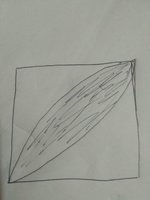Geometry
- Thread starter Sayem
- Start date
pka
Elite Member
- Joined
- Jan 29, 2005
- Messages
- 11,995
Go to this page: Circular SegmentsThis diagram shows a square of side 7 cm with 2 quadrants drawn inside.help me to find the shaded area and the way of finding it.
R=7 & c=27 because the diagonal is the chord and the central angle is θ=90o.
Steven G
Elite Member
- Joined
- Dec 30, 2014
- Messages
- 14,598
To OP, if this assumption is correct, then what is the shaded area??Are those rounded arcs exactly 1/4 circle?
pka
Elite Member
- Joined
- Jan 29, 2005
- Messages
- 11,995
To Sayem: Do you understand why there are forum rules that state that you should show your own work?This diagram shows a square of side 7 cm with 2 quadrants drawn inside.help me to find the shaded area and the way of finding it.
I gave you a reply which supplied with all the necessary tools necessary to solve this question.
But you choose not to even try to solve the question: you logged on at 3:15 today.
So we are left to conclude that you care only for the answer.
So here it is 2⋅13.9845.
I can tell you that you will find that answer useless beyond this one case.
Dr.Peterson
Elite Member
- Joined
- Nov 12, 2017
- Messages
- 16,762
Taking you at your word that you are asking for help with a way to find the area (there are many ways, not just "the" way), here is a very quick way:This diagram shows a square of side 7 cm with 2 quadrants drawn inside.help me to find the shaded area and the way of finding it.
Observe that if we add the areas of the two quadrants (quarter-circles), we will cover the entire square once, but the shaded region twice.
So what can you do with this result to find the area of the shaded region?
TTo Sayem: Do you understand why there are forum rules that state that you should show your own work?
I gave you a reply which supplied with all the necessary tools necessary to solve this question.
But you choose not to even try to solve the question: you logged on at 3:15 today.
So we are left to conclude that you care only for the answer.
So here it is 2⋅13.9845.
I can tell you that you will find that answer useless beyond this one case.
What does R and c mean in geometry?I dont know since i always have done the maths in my native language.Go to this page: Circular Segments
R=7 & c=27 because the diagonal is the chord and the central angle is θ=90o.
Dr.Peterson
Elite Member
- Joined
- Nov 12, 2017
- Messages
- 16,762
Go to this page: Circular Segments
R=7 & c=27 because the diagonal is the chord and the central angle is θ=90o.
pka gave you a link that defines the variables he used. Please read the link!What does R and c mean in geometry?I dont know since i always have done the maths in my native language.
R typically means radius; in this case, c means chord. But the definition (in this case, a picture labeled with variables) is necessary in order to know what is meant in a particular formula.
pka
Elite Member
- Joined
- Jan 29, 2005
- Messages
- 11,995
The shaded area in the diagram that you posted is the union of two non-intersecting circular segments with a common boundary the c in this case.What does R and c mean in geometry?I dont know since i always have done the maths in my native language.
Now that boundary is the diagonal of the square in which the circular sectors are inscribed. Therefore the radius R=7 & c=27.
Go to THIS LINK scroll down to the calculator section of the page. Enter the radius 7 and angle 90. Click Calculate it will give you the area of one half your area, area of one circular segment.

